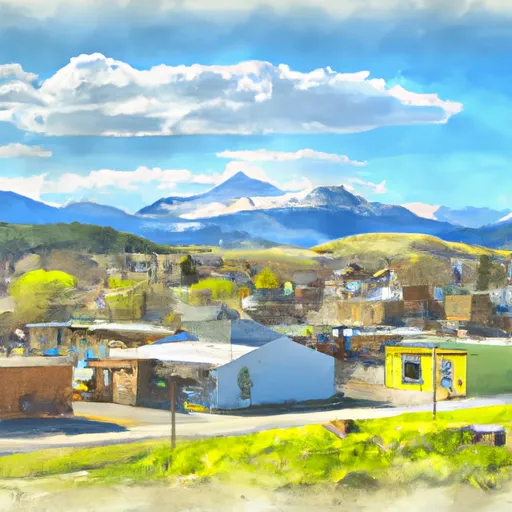-
 Snoflo Premium
Snoflo Premium
Get unlimited access to all our content
With no Ad interruptions! - Start Your Free Trial Login with existing account
Dillon
Eden Index
Climate
6.6
•
Recreation
3.0
•
Community
•
Safeguard
3.7/10

Dillon is a small town located in southwestern Montana, surrounded by beautiful mountain ranges and a diverse landscape. The climate in Dillon is characterized by cold winters and mild summers, making it an ideal destination for outdoor enthusiasts who enjoy skiing, snowmobiling, fishing, and hunting. The water quality in Dillon is high and has been rated as one of the best in the country, thanks to its low levels of pollutants and high levels of oxygen. The town is located near several rivers and streams, including the Beaverhead River, where visitors can enjoy fishing and kayaking. Additionally, Dillon is home to several parks and wildlife reserves, including the Beaverhead-Deerlodge National Forest, where visitors can hike, camp, and explore the natural beauty of Montana.
What is the Eden Index?
The Snoflo Eden Index serves as a comprehensive rating system for regions, evaluating their desirability through a holistic assessment of climate health, outdoor recreation opportunities, and natural disaster risk, acknowledging the profound impact of these factors on livability and well-being.
Climate Health Indicator (CHI): 6.6
Dillon receives approximately
273mm of rain per year,
with humidity levels near 63%
and air temperatures averaging around
6°C.
Dillon has a plant hardyness factor of
4, meaning
plants and agriculture in this region thrive during a short period during spring and early summer. Most
plants will die off during the colder winter months.
By considering the ideal temperature range, reliable water supplies, clean air, and stable seasonal rain or snowpacks, the Climate Health Indicator (CHI) underscores the significance of a healthy climate as the foundation for quality living.
A healthy climate is paramount for ensuring a high quality of life and livability in a region, fostering both physical well-being and environmental harmony. This can be characterized by ideal temperatures, reliable access to water supplies, clean air, and consistent seasonal rain or snowpacks.
Weather Forecast
Streamflow Conditions
Missouri Headwaters
Area Rivers
Missouri Headwaters
Snowpack Depths
Missouri Headwaters
Reservoir Storage Capacity
Missouri Headwaters
Groundwater Levels
Recreational Opportunity Index (ROI): 3.0
The Recreational Opportunity Index (ROI) recognizes the value of outdoor recreational options, such as parks, hiking trails, camping sites, and fishing spots, while acknowledging that climate plays a pivotal role in ensuring the comfort and consistency of these experiences.
Access to outdoor recreational opportunities, encompassing activities such as parks, hiking, camping, and fishing, is crucial for overall well-being, and the climate plays a pivotal role in enabling and enhancing these experiences, ensuring that individuals can engage in nature-based activities comfortably and consistently.
Camping Areas
| Campground | Campsites | Reservations | Toilets | Showers | Elevation |
|---|---|---|---|---|---|
| Salmon Fly FAS | 6 | 5,171 ft | |||
| Maidenrock FAS | 10 | 5,206 ft | |||
| Barretts Park - USBR | None | 5,254 ft | |||
| Glen FAS | 7 | 4,963 ft | |||
| Clark Canyon Reservoir | None | 5,623 ft | |||
| Notch Bottom FAS | None | 4,856 ft | |||
| Brownes Bridge FAS | 5 | 5,070 ft |
Nearby Fishing
Nearby Ski Areas
Catastrophe Safeguard Index (CSI):
The Catastrophe Safeguard Index (CSI) recognizes that natural disaster risk, encompassing floods, fires, hurricanes, and tornadoes, can drastically affect safety and the overall appeal of an area.
The level of natural disaster risk in a region significantly affects safety and the overall livability, with climate change amplifying these risks by potentially increasing the frequency and intensity of events like floods, fires, hurricanes, and tornadoes, thereby posing substantial challenges to community resilience and well-being.
Community Resilience Indicator (CRI):
The Community Resilience Indicator (CRI) recognizes that education, healthcare, and socioeconomics are crucial to the well-being of a region. The CRI acknowledges the profound impact of these elements on residents' overall quality of life. By evaluating educational resources, healthcare accessibility, and economic inclusivity, the index captures the essential aspects that contribute to a thriving community, fostering resident satisfaction, equity, and social cohesion.

